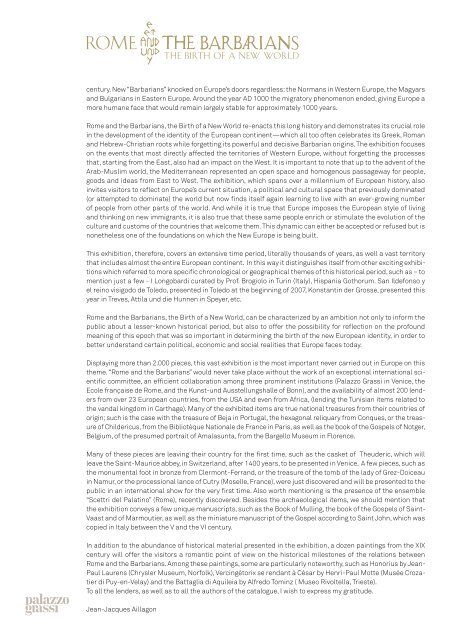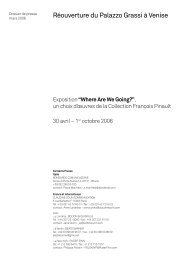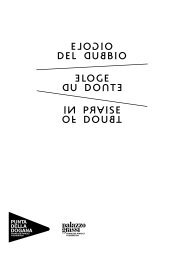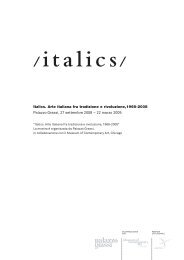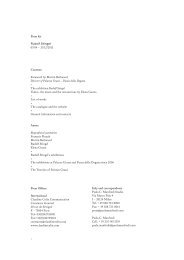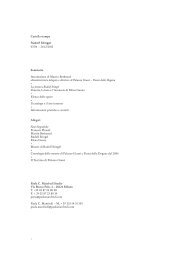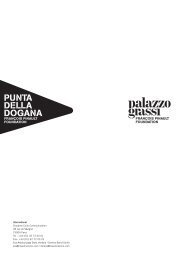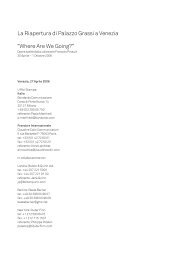pdf file, 819 Kb - Palazzo Grassi
pdf file, 819 Kb - Palazzo Grassi
pdf file, 819 Kb - Palazzo Grassi
Create successful ePaper yourself
Turn your PDF publications into a flip-book with our unique Google optimized e-Paper software.
century. New “Barbarians” knocked on Europe’s doors regardless: the Normans in Western Europe, the Magyars<br />
and Bulgarians in Eastern Europe. Around the year AD 1000 the migratory phenomenon ended, giving Europe a<br />
more humane face that would remain largely stable for approximately 1000 years.<br />
Rome and the Barbarians, the Birth of a New World re-enacts this long history and demonstrates its crucial role<br />
in the development of the identity of the European continent—which all too often celebrates its Greek, Roman<br />
and Hebrew-Christian roots while forgetting its powerful and decisive Barbarian origins. The exhibition focuses<br />
on the events that most directly affected the territories of Western Europe, without forgetting the processes<br />
that, starting from the East, also had an impact on the West. It is important to note that up to the advent of the<br />
Arab-Muslim world, the Mediterranean represented an open space and homogenous passageway for people,<br />
goods and ideas from East to West. The exhibition, which spans over a millennium of European history, also<br />
invites visitors to reflect on Europe’s current situation, a political and cultural space that previously dominated<br />
(or attempted to dominate) the world but now finds itself again learning to live with an ever-growing number<br />
of people from other parts of the world. And while it is true that Europe imposes the European style of living<br />
and thinking on new immigrants, it is also true that these same people enrich or stimulate the evolution of the<br />
culture and customs of the countries that welcome them. This dynamic can either be accepted or refused but is<br />
nonetheless one of the foundations on which the New Europe is being built.<br />
This exhibition, therefore, covers an extensive time period, literally thousands of years, as well a vast territory<br />
that includes almost the entire European continent. In this way it distinguishes itself from other exciting exhibitions<br />
which referred to more specific chronological or geographical themes of this historical period, such as – to<br />
mention just a few - I Longobardi curated by Prof. Brogiolo in Turin (Italy), Hispania Gothorum. San Ildefonso y<br />
el reino visigodo de Toledo, presented in Toledo at the beginning of 2007, Konstantin der Grosse, presented this<br />
year in Treves, Attila und die Hunnen in Speyer, etc.<br />
Rome and the Barbarians, the Birth of a New World, can be characterized by an ambition not only to inform the<br />
public about a lesser-known historical period, but also to offer the possibility for reflection on the profound<br />
meaning of this epoch that was so important in determining the birth of the new European identity, in order to<br />
better understand certain political, economic and social realities that Europe faces today.<br />
Displaying more than 2.000 pieces, this vast exhibition is the most important never carried out in Europe on this<br />
theme. “Rome and the Barbarians” would never take place without the work of an exceptional international scientific<br />
committee, an efficient collaboration among three prominent institutions (<strong>Palazzo</strong> <strong>Grassi</strong> in Venice, the<br />
Ecole française de Rome, and the Kunst-und Ausstellungshalle of Bonn), and the availability of almost 200 lenders<br />
from over 23 European countries, from the USA and even from Africa, (lending the Tunisian items related to<br />
the vandal kingdom in Carthage). Many of the exhibited items are true national treasures from their countries of<br />
origin; such is the case with the treasure of Beja in Portugal, the hexagonal reliquary from Conques, or the treasure<br />
of Childericus, from the Bibliotèque Nationale de France in Paris, as well as the book of the Gospels of Notger,<br />
Belgium, of the presumed portrait of Amalasunta, from the Bargello Museum in Florence.<br />
Many of these pieces are leaving their country for the first time, such as the casket of Theuderic, which will<br />
leave the Saint-Maurice abbey, in Switzerland, after 1400 years, to be presented in Venice. A few pieces, such as<br />
the monumental foot in bronze from Clermont-Ferrand, or the treasure of the tomb of the lady of Grez-Doiceau<br />
in Namur, or the processional lance of Cutry (Moselle, France), were just discovered and will be presented to the<br />
public in an international show for the very first time. Also worth mentioning is the presence of the ensemble<br />
“Scettri del Palatino” (Rome), recently discovered. Besides the archaeological items, we should mention that<br />
the exhibition conveys a few unique manuscripts, such as the Book of Mulling, the book of the Gospels of Saint-<br />
Vaast and of Marmoutier, as well as the miniature manuscript of the Gospel according to Saint John, which was<br />
copied in Italy between the V and the VI century.<br />
In addition to the abundance of historical material presented in the exhibition, a dozen paintings from the XIX<br />
century will offer the visitors a romantic point of view on the historical milestones of the relations between<br />
Rome and the Barbarians. Among these paintings, some are particularly noteworthy, such as Honorius by Jean-<br />
Paul Laurens (Chrysler Museum, Norfolk), Vercingétorix se rendant à César by Henri-Paul Motte (Musée Crozatier<br />
di Puy-en-Velay) and the Battaglia di Aquileia by Alfredo Tominz ( Museo Rivoltella, Trieste).<br />
To all the lenders, as well as to all the authors of the catalogue, I wish to express my gratitude.<br />
Jean-Jacques Aillagon


